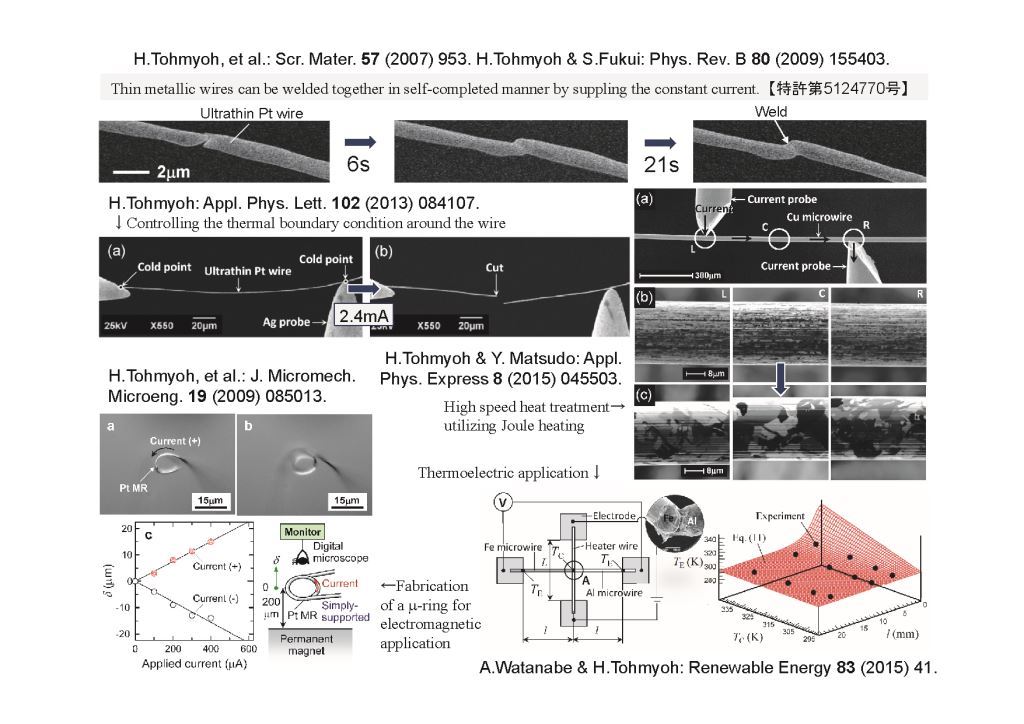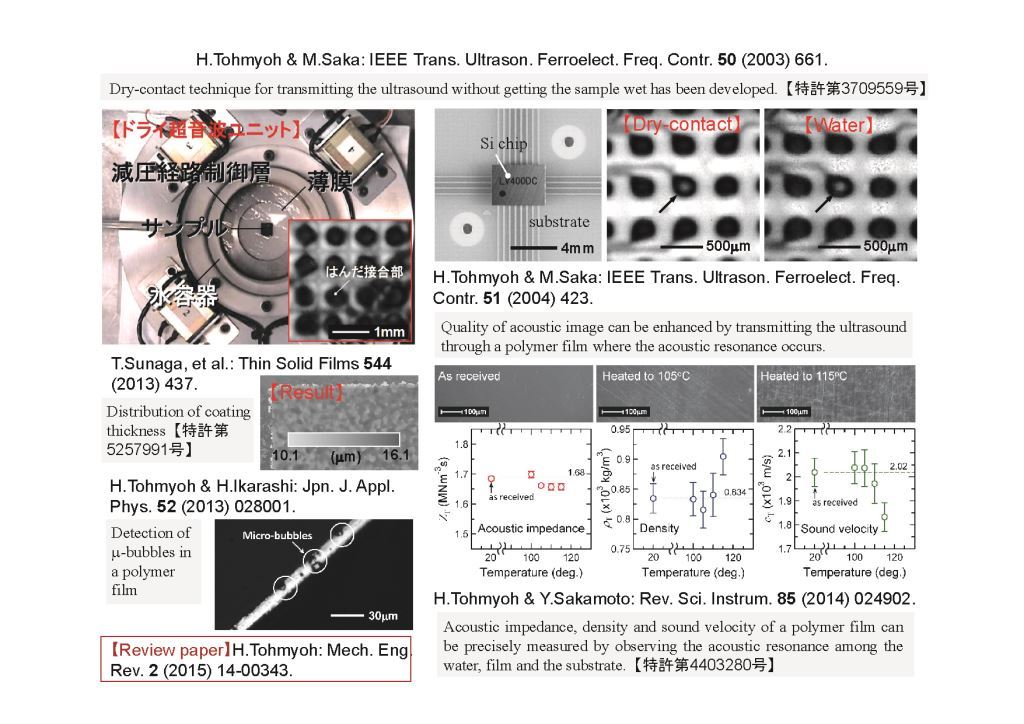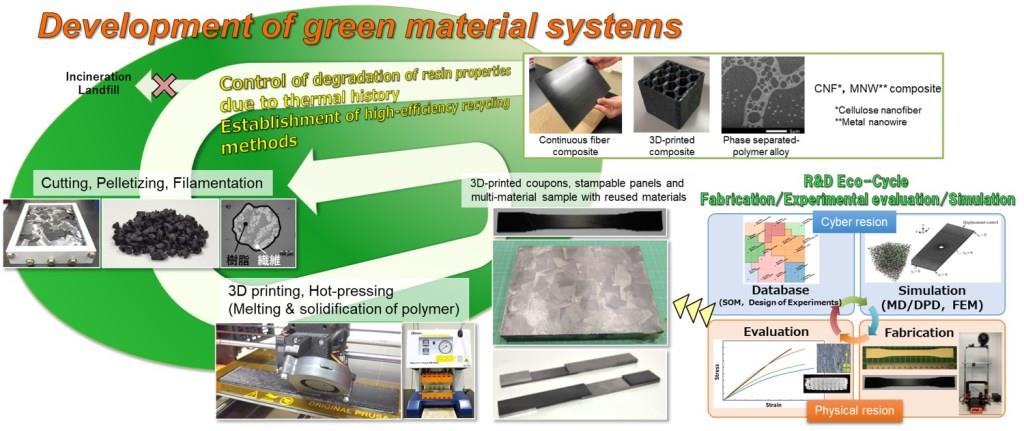[Tohmyoh & Kimura Lab.]
Joining and Modification of fine-scale materials by Joule heating
We aim to create an advanced materials system through an interdisciplinary approach (Fig. 1). In order to freely use micro/nano materials, which have excellent physical properties and unique geometrical features, techniques for joining and modifying the crystal structure of such fine-scale materials have been developed. When the constant current is supplied to the contacting portion of metallic wires, the portion melts by Joule heating, and then solidify. By discovering the governing parameter of this phenomenon, two wires were welded together with a higher probability. Crystal structure of thin wire is modified by Joule heating to recover its formability.
Thermoelectric power generation from a thin plate
Thermoelectric function has been created from thin plate or wire. A plate-type thermoelectric power generator, where the bi-metal interface was realized by depositing Al layer on the surface of the Fe plate, has been developed for power generation from a small temperature difference. It has been clarified that oxidizing the bi-metal interface is effective to enhance its thermoelectric performance. In addition, thermoelectric microwire was fabricated for temperature sensing in a local area.
Advanced ultrasonic materials evaluation
A dry-contact ultrasonic technique has been developed to realize the ultrasonic imaging without getting the electronic device wet (Fig. 2). Here, the high frequency ultrasound is transmitted into the sample via a thin film inserted between the water and the sample. Furthermore, layered media, such as polymer film and coating, were successfully characterized utilizing the acoustic resonance that occurs when ultrasound passes through thin layer.
Mechanical testing of micro/nano materials
In order to create advanced materials system from fine-scale materials, understanding the various physical properties of such materials is vital. To evaluate the mechanical properties of micro/nano materials, a force sensor to measure the micro-newton force has been developed, and the mechanical testing on micro/nano materials is conducted. In addition, the electrical properties of micro/nano materials are evaluated by eddy current microscopy or small-scale potential drop technique.
Characterization of human hair and nail
Human hair and nail have been found to hold various information about our disease and aging, and therefore, these are expected to be used as specimens for medical diagnostics like blood or urine in the future. For this purpose, the deformability of such biomaterials was examined by bending and tensile tests, and the effects of water absorption and metal ion content on their deformability were investigated. In addition, factors that decide the shape of human hair are also investigated.
[Shirasu Lab.]
Development of green material systems utilizing thermoplastic resins
This laboratory is conducting research and development toward the creation of green material systems using thermoplastic composites containing thermoplastic resin, carbon fiber, and nanofiller for the realization of carbon neutrality. For example, the additive manufacturing by 3D printing and direct bonding to dissimilar materials can reduce the cutting and bonding processes. Adhesive bonding not only contributes to the reduction of drilling and fastening work for mechanical fastening, but also to the reduction of CO2 emissions by reducing weight through the reduction of metal fasteners. In the future, material design that takes recycling of materials into consideration will also be important, and research will be conducted with a view to cascade recycling of composite materials, understanding of material degradation behavior due to melting and solidification of thermoplastic resins, and the use of biodegradable plastics.
R&D scheme based on a cycle of material synthesis/molding/experimental evaluation/simulation
This laboratory promotes research on efficient development of new materials and elucidation of their structure, deformation, and fracture behavior by cycling an R&D eco-cycle based on (1) material synthesis and molding, including resin synthesis, composite molding, and 3D additive manufacturing, (2) experimental evaluation, including tensile tests, interfacial fracture toughness tests, thermal analysis, and structural observation, and (3) analysis, including finite element analysis and molecular dynamics simulations.
Development of technology for joining dissimilar materials of thermoplastic composites/metals by 3D printing and evaluation of mesoscale interface strength
In recent years, composite material fabrication technology has been developed using a fused filament fabrication (FFF) 3D printer, which enables automatic three-dimensional fabrication of high-strength and high-rigidity composite materials at low cost and in a short period of time. In this study, we develop a multi-material structure made of fiber-reinforced thermoplastics directly formed on a metal substrate, and evaluate the mode I and II fracture toughness and lap shear strength of the bonded interface by both experiments and finite element analysis.
Material characterization, advanced structural characterization, and molecular structure modeling of phase-separated polymer alloys
Polymer alloys are thermoset/thermoplastic composites in which thermoplastic resins are blended with thermosetting resins such as epoxy resins to improve their low toughness. In this study, we aim to elucidate the network structure of phase-separated polymer alloys and the mechanism of various material properties by advanced measurements using electron microscopy and spectroscopic analysis and molecular structure modeling using molecular dynamics simulations.
Evaluation of degradation behavior of base resin during melting and solidification cycles for highly efficient recycling of thermoplastic composites
Thermoplastic composites have attracted attention in recent years as sustainable materials that can be remolded, manufactured at low cost, and have a low environmental impact. In order to create green material systems, it is necessary to fully understand the effects of molding conditions and changes in the structure and properties of resins during the melting and solidification processes. This study aims to elucidate the changes in the structure and properties of thermoplastic resins and composites as they undergo melting and resolidification cycles.



